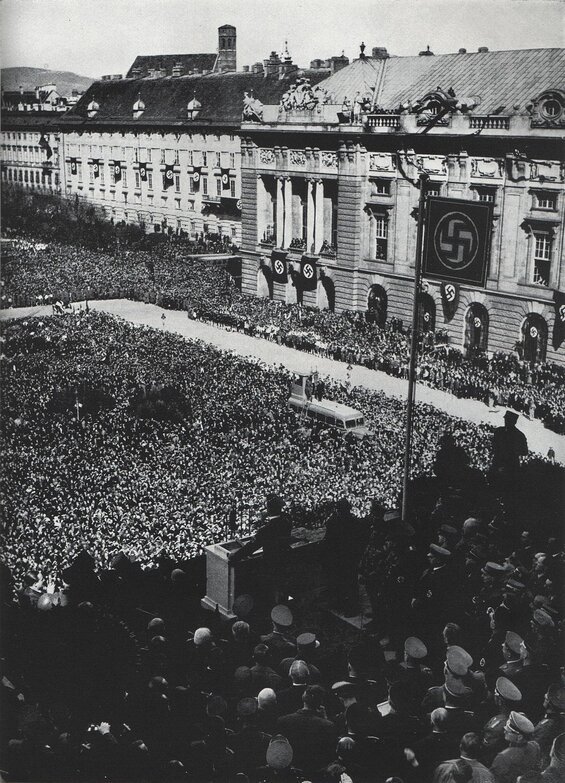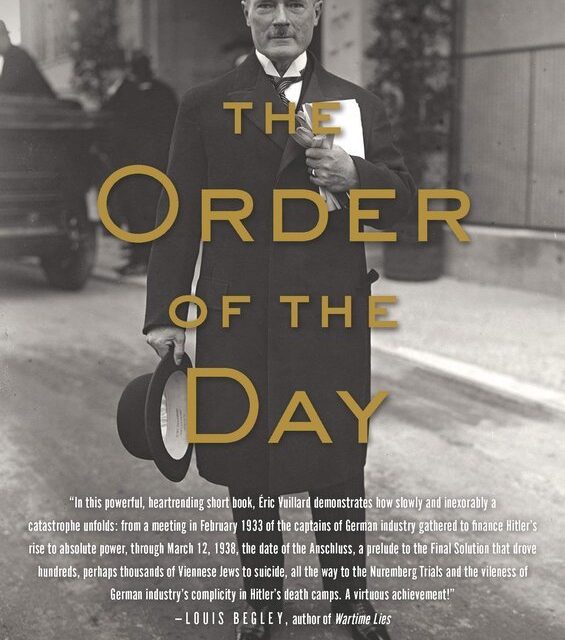
There’s something strange about the French. I suspect that any American publisher would have rejected this peculiar little book. But it wasn’t just published in France—it won the country’s most prestigious literary award, the Prix Goncourt. And this despite the fact that in fewer than 150 pages the author wanders from one anecdote to another and still manages to find room for off-topic digressions along the way. Oh, there’s a topic, all right: The Order of the Day is (mostly) about the diplomatic maneuvering and manipulation that led up to Nazi Germany’s Anschluss with Austria in March 1938. But it’s also about a fateful meeting in February 1933 that ensured Adolf Hitler’s rise to power. And author Éric Vuillard also relates the comic-opera tale of the annexation itself, when Nazi troops swarmed into the country, kicking off Adolf Hitler’s war—and tripped over one another in the process.
Embarrassing details ignored by history books
To be fair, Vuillard writes exceptionally well (or at least his translator does). And the anecdotes, which report on meetings with Hitler and his henchmen, are brilliant. Vuillard gets up-close and personal with the likes of Britain’s Foreign Secretary Lord Halifax (1881-1959), Austria’s Chancellor Kurt Schuschssnigg (1897-1977), and the German Industrialists who financed Hitler’s rise. He reveals embarrassing details of the sort that never seem to make it into the history books, including the astonishing scene of Adolf Hitler blocked on the road into Austria by his own stalled Panzer tanks. For any reader seeking insight into the crucial years in the mid-1930s and the Anschluss that cast the die for the Second World War, The Order of the Day makes for fascinating reading.
The Order of the Day by Éric Vuillard (2017) 144 pages ★★★★☆
Winner of the 2017 Prix Goncourt

Austrian citizens crowding a plaza in Vienna to hear Hitler’s declaration of annexation. Image: Wikipedia
An “old fox” meets the Führer before the Anschluss with Austria
Here, for example, is Foreign Secretary “Halifax, the old fox,” meeting Hermann Göring. “And then he met the Führer, and again Hailfax didn’t notice a thing. Ignoring Anthony Eden‘s reservations, he went so far as to intimate to Hitler that Germany’s designs on Austria and part of Czechoslovakia did not seem unwarranted to His Majesty’s government.” Later, he would write to Prime Minister Stanley Baldwin that “Nationalism and Racialism is a powerful force but I can’t feel that it’s either unnatural or immoral.” And this man served as Foreign Secretary to both Neville Chamberlain and Winston Churchill and as a member of Churchill’s War Cabinet.
The 24 men who financed Hitler’s rise to power
But all the back and forth about the Anschluss with Austria isn’t really Vuillard’s main concern at all. The Order of the Day opens and closes with Vuillard’s observations about the twenty-four men who attended a secret meeting with Adolf Hitler on February 20, 1933. They were the cream of Germany industry and finance, men such as Gustav Krupp (1870-1950), Wilhelm von Opel (1871-1948), and Albert Vögler (1877-1945). They had come together at the request of the Führer‘s economic adviser, Hjalmar Schacht (1877-1970), to hear an appeal for campaign contributions from Hermann Göring and Adolf Hitler himself.
And they gave. Oh, yes, they gave, quite enough to pave the way for the little corporal to gain enough electoral support and soon proclaim himself dictator. This was “nothing more for the Krupps, Opels, and Siemenses than a perfectly ordinary business transaction, your basic fund-raising.” For these were the men who led the firms that had powered Germany into the forefront of the European economy: BASF, Bayer, Agfa, Opel, IG Farben, Siemens, Allianz, Telefunken. It was they, as much as Adolf Hitler, who eased Germany toward the Anschluss with Austria.
Their dividends: slaves from the camps
As Vuillard notes in conclusion, that investment in the Nazi Party paid huge dividends for those twenty-four men. “Bayer took on laborers from Mauthausen. BMW hired in Dachau, Papenburg, Sachsenhausen, Natzweiler-Struthof, and Buchenwald.” And so it was with all the others—Daimler, IG Farben, Shell, Telefunken, Agfa. They all drew slaves from the camps—and worked them to death on a starvation diet and punishing schedules. “Of the six hundred deportees who arrived at the Krupp factories in 1943,” Vuillard writes, “only twenty remained a year later.”
About the author

Éric Vuillard (1968-) is one of France’s most prominent and prolific authors as well as a filmmaker of note. He has won literary awards for nine of his books.
For more reading
Check out 20 top nonfiction books about history.
You might also enjoy:
- 10 top nonfiction books about World War II
- The 10 best novels about World War II)
- 7 common misconceptions about World War II
- The 10 most consequential events of World War II
And you can always find my most popular reviews, and the most recent ones, plus a guide to this whole site, on the Home Page.



























